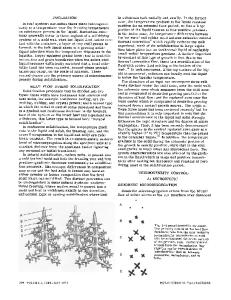High-frequency susceptibility of a superlattice with 2D inhomogeneities
- PDF / 297,340 Bytes
- 9 Pages / 612 x 792 pts (letter) Page_size
- 81 Downloads / 328 Views
SORDER, AND PHASE TRANSITION IN CONDENSED SYSTEMS
High-Frequency Susceptibility of a Superlattice with 2D Inhomogeneities V. A. Ignatchenkoa, Yu. I. Mankova,b, and D. S. Tsikalovb a L.V.
Kirenskii Institute of Physics, Russian Academy of Sciences, Siberian Branch, Krasnoyarsk, 660036 Russia b Siberian Federal University, Krasnoyarsk, 660062 Russia e-mail: [email protected] Received April 7, 2008
Abstract—We investigate the high-frequency susceptibility (Green function) of an initially sinusoidal 1D superlattice with 2D phase inhomogeneities that model the deformations of the interfaces between the superlattice layers. For waves propagating along the superlattice axis (the geometry of a photon or magnon crystal), we have found a peculiar behavior of the imaginary part of the Green function that consists in a significant difference between the peaks corresponding to the edges of the band gap in the wave spectrum. The peak corresponding to the lower-frequency band edge remains essentially unchanged as the root-mean-square fluctuation of the 2D inhomogeneities γ2 increases, while the peak corresponding to the higher-frequency band edge broaden and decreases sharply in height until its complete disappearance with increasing γ2. This behavior of the peaks corresponds to a band gap closure mechanism that differs from the traditional one characteristic of 1D and 3D inhomogeneities. These effects can be explained by a peculiarity of the energy conservation laws for the incident and scattered waves for 2D inhomogeneities in a 1D superlattice. PACS numbers: 68.65.-k, 75.30.Ds, 68.65.Cd DOI: 10.1134/S1063776108100075
1. INTRODUCTION At present, multilayered film structures (1D superlattices) that consist of periodically alternating layers of two or more materials with different physical properties are being investigated extensively. In particular, photon and magnon crystals that have received much attention belong to such structures. The spectrum of waves of any nature in periodic systems is known to have a band structure characterized by the reciprocal lattice vector q (|q | ≡ q = 2π/l, where l is the 1D superlattice period). The degeneracy is removed and band gaps ∆ωn appear at the edge of the Brillouin zones in a superlattice at k = nq/2. The gap width is determined by the change in the physical parameters of the neighboring layers and by the band number n. In actual materials, an ideal periodicity in the arrangement of layers can be maintained only approximately. There are always random deviations from periodicity due to natural or technological factors; the purposeful formation of a particular aperiodicity is also possible. This has stimulated the appearance of theoretical works in which the transition from ideally periodic superlattices to partially stochastized ones is studied. Several theoretical methods have been developed to date to investigate the spectral properties of such superlattices: the introduction of a 1D random phase [1, 2]; modeling the disorder in the arrangement of layers of
two different materials
Data Loading...










